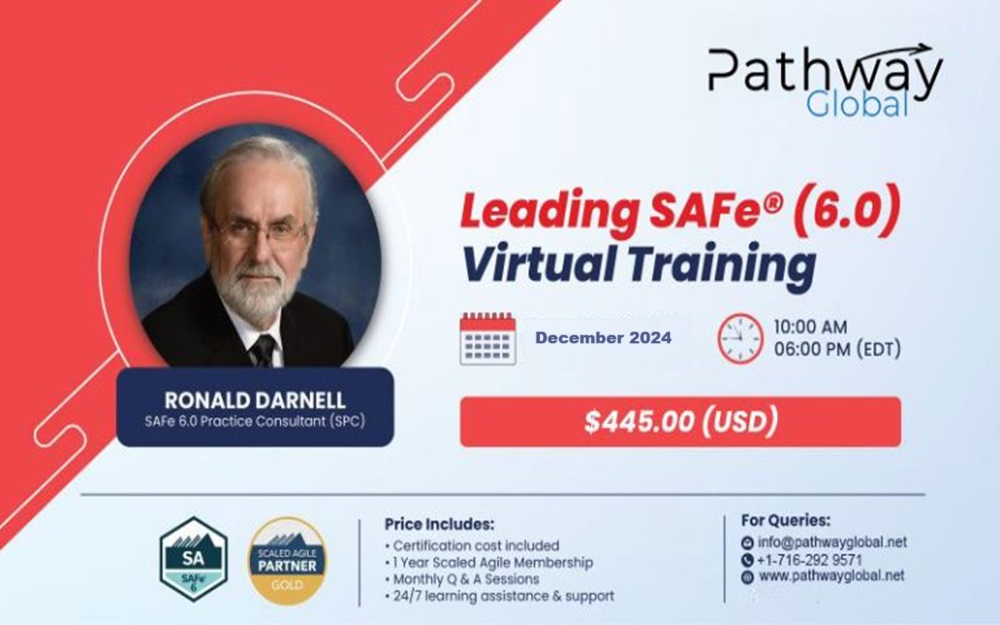Leading SAFe Certification
Training Details
SAFe® and Scaled Agile Framework® are registered trademarks of Scaled Agile, Inc. This course is not endorsed by or affiliated with Scaled Agile, Inc. This course does not provide official Scaled Agile Framework® (SAFe®) certification. For more information about SAFe®
Scaled Agile Framework® 6.0 (SAFe®) stands as a leading scaling framework for Agile implementation at an enterprise level. To comprehend SAFe®, a deep understanding of Agile and Scrum is necessary. This course is meticulously designed to eliminate any prerequisites for SAFe® by providing concise introductions to Agile, Scrum, and subsequently, the Scaled Agile Framework®. Despite the complexity of SAFe®, this course simplifies each topic to facilitate better understanding for students.
We cover introductory aspects such as:
SAFe® Core Values
SAFe® Principles
Various SAFe® Configurations
SAFe® Events
Roles and Responsibilities in SAFe®
PI Planning (Program Increment Planning)
Complete Program Increment (PI) Cycle
Various SAFe® Certifications offered by Scaled Agile Framework® for different roles
In-depth coverage includes: SAFe® 6.0 Big Picture and Self-Study SAFe® Implementation Roadmap Lean Agile Mindset Flow and Flow Accelerators Weighted Shortest Job First (WSJF) Inspect and Adapt Event
Who Should Take This Course: Agile Practitioners: Those familiar with Agile principles seeking to deepen their understanding of scaling Agile in large enterprises. Project Managers: Leaders or participants in Agile transformations looking to scale Agile practices across multiple teams and projects. Scrum Masters and Agile Coaches: Professionals guiding teams and organizations in adopting Agile methodologies, exploring SAFe® principles and frameworks. Product Owners and Product Managers: Individuals defining product strategies and managing backlogs, aligning work with SAFe® principles. Team Leaders and Managers: Those accountable for delivering value to customers and stakeholders, leveraging SAFe® to improve productivity and collaboration. Executives and Business Leaders: Individuals driving organizational change, seeking insights into scaling Agile practices to achieve strategic objectives. IT and Software Development Professionals: Those interested in adopting Agile methodologies, leveraging SAFe® to streamline processes, improve quality, and accelerate time-to-market.
Upon completing this course, you will:
- Introduction to SAFe®: Delve into the fundamental concepts and principles that underpin SAFe®, elucidating how it addresses the complexities of scaling Agile methodologies in larger enterprises.
- SAFe® Principles: Explore the foundational principles that serve as guiding beacons for SAFe®, encompassing alignment, built-in quality, transparency, and effective program execution.
- SAFe® Frameworks: Navigate through the diverse frameworks offered within SAFe®, including Essential SAFe, Large Solution SAFe, Portfolio SAFe, and Full SAFe, each tailored to specific organizational needs.
- Roles and Responsibilities: Gain valuable insights into the varied roles and responsibilities within a SAFe organization, ranging from Release Train Engineers (RTEs) and Scrum Masters (SMs) to Product Owners (POs) and leadership positions.
- Program Increment (PI) Planning: Learn about the critical PI Planning event, where cross-functional teams come together to synchronize and plan their work for the upcoming Program Increment.
- Lean Portfolio Management: Delve into the principles and practices of Lean Portfolio Management, crucial for aligning organizational strategy with execution and optimizing resource allocation.
- SAFe® Implementation Roadmap: Gain valuable insights into the SAFe® implementation roadmap, including strategies for successful adoption, common implementation challenges, and effective mitigation strategies.
- Scaled Agile Leadership: Explore the pivotal role of leadership in driving and sustaining organizational change within a SAFe environment, emphasizing the importance of visionary leadership and continuous improvement.
